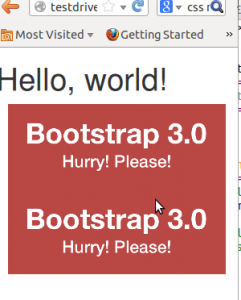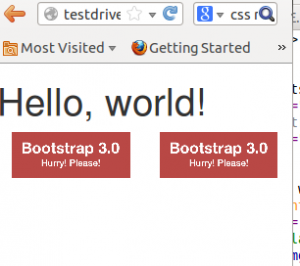Release Candidate 2 has important changes for the grid and the grid classes. Read Twitter’s Bootstrap 3 RC2 (important changes)
 The most important changes in Twitter Bootstrap 3 will be the more mobile-first approaching and the grid. From now Twitter’s Bootstrap defines three grids: Tiny grid for Phones (<768px), Small grid for Tablets (<992px) and the Medium-large grid for Destkops (>992px). The row class prefixes for these grid are “.col-”, “.col-sm-” and “.col-lg-”. The Medium-large grid will stack below 992 pixels screen width. So does the Small grid below 768 pixels and the tiny grid never stacks. (updated for Twitter’s Bootstrap3 RC1)
The most important changes in Twitter Bootstrap 3 will be the more mobile-first approaching and the grid. From now Twitter’s Bootstrap defines three grids: Tiny grid for Phones (<768px), Small grid for Tablets (<992px) and the Medium-large grid for Destkops (>992px). The row class prefixes for these grid are “.col-”, “.col-sm-” and “.col-lg-”. The Medium-large grid will stack below 992 pixels screen width. So does the Small grid below 768 pixels and the tiny grid never stacks. (updated for Twitter’s Bootstrap3 RC1)
Twitter’s Bootstrap 2 defines breakpoints at 480px, 768px, 980px and 1200px. The layout will always be fluid below 768px.
For this reason the ‘old’ span* will not be the same as col-* or col-lg-*. So replacing the class names in your templates will be give you better results. But when looking to an example like http://examples.getbootstrap.com/jumbotron/index.html you will find the the col-lg-* class in place of the former span* class.
Breakpoints
In variables.less you will find:
// Media queries breakpoints
// --------------------------------------------------
// Extra small screen / phone
@screen-xsmall: 480px;
@screen-phone: @screen-xsmall;
// Small screen / tablet
@screen-small: 768px;
@screen-tablet: @screen-small;
// Medium screen / desktop
@screen-medium: 992px;
@screen-desktop: @screen-medium;
// Large screen / wide desktop
@screen-large: 1200px;
@screen-large-desktop: @screen-large;
// So media queries don't overlap when required, provide a maximum
@screen-small-max: (@screen-medium - 1);
@screen-tablet-max: (@screen-desktop - 1);
@screen-desktop-max: (@screen-large-desktop - 1);
// Grid system
// --------------------------------------------------
// Number of columns in the grid system
@grid-columns: 12;
// Padding, to be divided by two and applied to the left and right of all columns
@grid-gutter-width: 30px;
// Point at which the navbar stops collapsing
@grid-float-breakpoint: @screen-tablet;When i test this values if found something different:
- “col-*” will be applied always (never stacks)
- “col-sm-*” will be applied between 768 and higher (992px) (stacks at 767)
- “col-lg-*” will be applied between 992 and higher (stacks at 991)
NOTE: @screen-small is not in use at the moment.
See also http://examples.getbootstrap.com/grid/ for more examples of the grids.
The grid of Twitter Bootstrap 3 has been change to fluid by default. Twitter Bootstrap 3 has only one breakpoint. We will find this breakpoint at 768 pixels. This breakpoint splits small screens and large screens.
Both sides of the breakpoint have a 12 column wide grid. Only modern phone will use the mobile grid, older phoned should only stack. Class names for span and offset are change to col-span-* and -*. Also Twitter Bootstrap 3 introduce new classes (col-small-span-*) for stacking in the mobile grid. You will use this new classes in combination with the standard span and offset classes for large devices:
Imagine you will add two image next to each other in a row.
Twitter Bootstrap 2: (old situation)
<div class=”row”>
<div class=”span6″><img src=”image1.png”></div>
<div class=”span6″><img src=”image1.png”></div>
</div>
On small screens the images will stack with a 100% width in a fluid layout.
Twitter bootstrap 3:
<div class=”row”>
<div class=”col-span-6″><img src=”image1.png”></div>
<div class=”col-span-6″><img src=”image1.png”></div>
</div>
Without adding the mobile classes the images will don’t use the mobile grid and stack with 100% width.
(Note this differs from my expectation. I expected the main classes also should influence the mobile grid.)
Now we could add the new classes and let the images show next to each other with 50% width:
<div class=”row”>
<div class=”col-span-6 col-small-span-6″><img src=”image1.png”></div>
<div class=”col-span-6 col-small-span-6″><img src=”image1.png”></div>
</div>
You can also use this class to change the way of stacking:
<div class=”row”>
<div class=”col-span-4 col-small-span-12″><img src=”image1.png”></div>
<div class=”col-span-4 col-small-span-6″><img src=”image1.png”></div>
<div class=”col-span-4 col-small-span-6″><img src=”image1.png”></div>
</div>
So we lost some breakpoints but got a small device grid back. Remember offsets are not available with the small grid. Two other new classes are col-pull-* and col-push-*. This classes help you to change the order of your columns. Also these classes are not available with the small grid.
Large screens
The new fluid grid without a default width also lets me think about large screens again. Should i made a decision about the max width of my site when viewed on a large screen? Users who use a site on an large screen with a full screen browsers window should have a reason to do so. So it seems to be more user friendly to let the user choose the max width. I found an interesting article about this: Life Beyond 960px: Designing for Large Screens. At the moment the .container class provides max-widths (728px, 940px en 1170px) for the large grid.



One Response to “Twitter Bootstrap 3 breakpoints and grid”